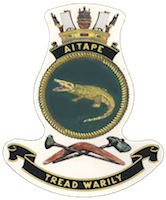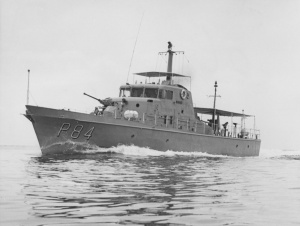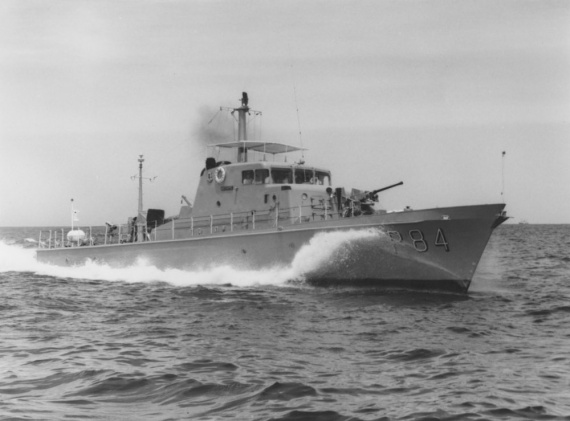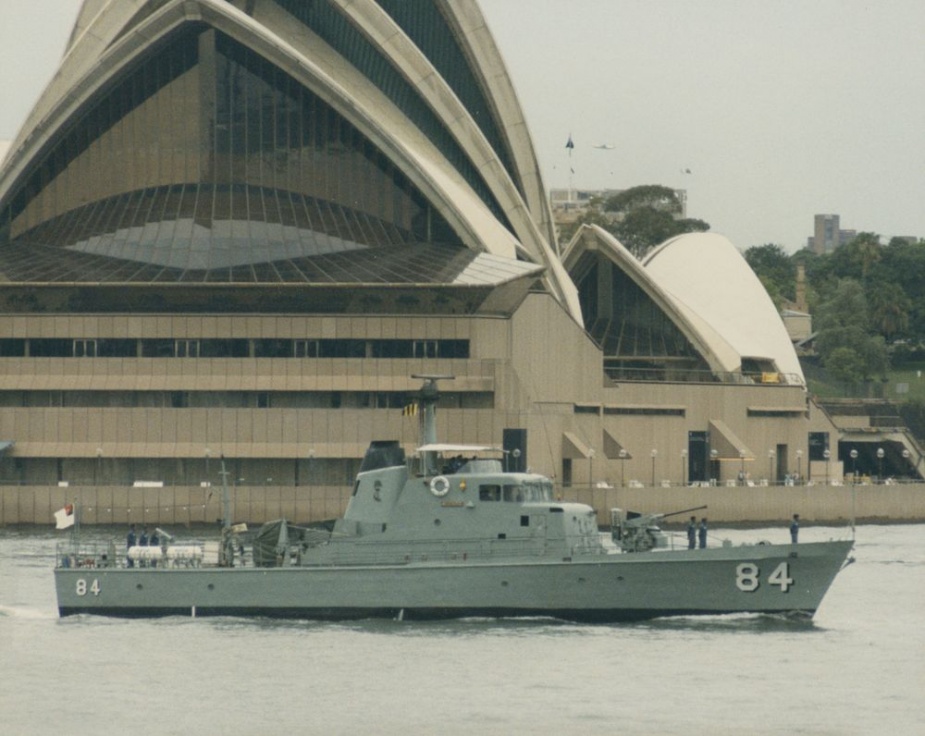HMAS Aitape
| Class |
Attack Class Patrol Boat |
|---|---|
| Type |
Patrol Boat |
| Pennant |
P84 |
| Motto |
Tread Warily |
| Builder |
Walkers Ltd, Maryborough, Queensland |
| Launched |
6 July 1967 |
| Commissioned |
13 November 1967 |
| Decommissioned |
14 November 1974 |
| Fate |
Transferred to Papua New Guinea Defence Force Maritime Element |
| Dimensions & Displacement | |
| Displacement | 146 tonne |
| Length | 32.76 metres |
| Beam | 6.2 metres |
| Draught | 1.9 metres |
| Performance | |
| Speed | 24 knots |
| Complement | |
| Crew | 21 |
| Propulsion | |
| Machinery | Twin Paxman Diesels |
| Armament | |
| Guns |
|

HMAS Aitape commissioned under the command of Lieutenant WSG 'Sam' Bateman, RAN at HMAS Moreton in Brisbane on 13 November 1967. She was one of twenty Attack Class patrol boats ordered for the RAN in November 1965. The Attack Class was equipped with high-definition navigation radar, magnetic compasses, an echo sounder and air conditioning for service in northern Australian waters. Their primary role was to conduct patrol work in Australian territorial waters, which, for Aitape and four other Attack Class patrol boats, included Papua New Guinea (PNG) which was an Australian protectorate until 1975.
Aitape embarked the General Officer Commanding, Northern Command, Major-General Timothy Cape, OBE, DSO, for a familiarisation cruise up the Brisbane River on 14 November before departing Brisbane for Sydney on 22 November in company with her sister ship HMAS Attack. The two patrol boats then began work-up exercises on 30 November, participating in Exercises WINDLIGHT and CLOUDLIGHT in December although adverse weather conditions limited their respective contributions.
With work-ups competed, the two vessels departed Sydney on 20 December spending Christmas Day in Cairns before continuing on their respective deployments on Boxing Day.
Aitape arrived in Port Moresby, PNG, on 29 December where her Commanding Officer called on the Administrator, Mr David Hay, CBE, DSO (who had been awarded his DSO for his part in the Aitape/Wewak campaign during World War II), senior administration and military staff. The ship’s company then spent New Year’s Eve at Samarai in Milne Bay. Sailing the following day, Aitape continued on to her new home port at HMAS Tarangau in Lombrum, Manus Island arriving on 3 January 1968. There she was warmly welcomed by local officials and residents and her crew was treated to a welcoming ‘sing-sing’ on the wharf.
Aitape was later joined by HMAS Samarai in April, HMAS Lae in July, HMAS Ladava in December and HMAS Madang the following year in March 1969. Together they formed the PNG Division of the patrol boat force.
After a brief period of maintenance and training, Aitape cast off for her first patrol in the north west New Guinea area on 15 January 1968 with a number of PNG sailors embarked for training. The patrol included a visit to Wewak where Aitape’s radio operator was landed for medical attention after suffering a high fever. She also conducted a visit to her namesake port, Aitape, on 21 January. On 23 January, while approaching Lombrum, Aitape suffered a complete engine failure and drifted for about an hour before the port main engine was restarted enabling her to continue to her berth alongside.
Aitape soon settled into a routine program of patrols, exercises and maintenance while also providing training for PNG sailors. She would regularly visit remote locations and local coast watchers which included visits to the British protectorate of the Solomon Islands. Public relations was a major aspect of Aitape’s duties, not only being visible but imparting a positive impression of both the RAN and Australia upon local communities.
In August Aitape operated in support of the RAN Experimental Laboratory (RANEL) under the auspices of Project Barrabool, and during September and October she participated in Exercise CORAL SANDS off the coast of New Britain. Unfortunately a defect in the starboard main engine forced her withdrawal from the exercise on 3 October and she made for Port Moresby where a crack in her hull was also detected. With the slipways at Port Moresby unavailable, she was redirected to Madang on 14 October for repairs and was back at sea three days later.
The Christmas and New Year period was interrupted following the sighting of two foreign fishing vessels (one Russian and the other Japanese) operating in the Gulf of Papua. Aitape put to sea on 29 December to investigate and patrolled until 6 January 1969 but neither was located.
Aitape made her first apprehension when a Formosan fishing vessel was sighted near Tolokiwa Island on 12 February. After observing the vessel throughout the evening, Aitape intercepted her in the early hours of the next morning taking her in tow to Lae.
In February Aitape was joined by HMAS Ladava (Lieutenant Commander Blenkinsopp, RAN) to undertake a three day navigational passage into the mighty Sepik River. Together the two patrol boats ventured 230 miles inland setting a new record for the RAN. A Navy public relations team was embarked for the journey and the exploits of the two Attack Class vessels can be viewed in the short documentary entitled Navigating the Sepik.
Aitape was briefly back in Australian waters when she visited Thursday Island from 2 to 5 May 1969. She participated in Exercise OLGETA TRU with Army personnel from the PNG Cadet School in June and the following month departed Tarangau for a major refit in Sydney, which included the replacement of both main engines and generators. She arrived in Sydney on 28 July and the PNG sailors aboard took the rare opportunity to undertake a number of training courses while they were in Australia. The refit completion date was pushed back by some seven weeks due to industrial action on Sydney’s wharves but Aitape was finally back at sea for post-refit trials on 26 November. After a period of shakedown and work-ups, she departed Sydney for PNG on 8 December. She arrived in Port Moresby on 17 December and returned to Tarangau five days later.
The new year saw Aitape continue a routine program of patrols, exercises and maintenance and on 9 January 1970 she rescued eleven Indonesian men and one woman from a stricken merchant vessel which had run aground on a reef west of Manus Island. The vessel, MV Xaverius, had been adrift for over six weeks when she grounded and her crew, all of whom survived the ordeal, had subsisted on a diet of margarine and flour from the ship’s cargo.
Aitape participated in the anti-infiltration Exercise WOK-WARA in April and squadron exercises in June. On 15 July she came to the assistance of HMAS Lae which had run aground on the north coast of New Britain the previous day. Lae was successfully re-floated on 17 July. Aitape also suffered a number of mechanical defects in July including a steering gear breakdown and a defect in the starboard engine in August which took three days to rectify. She briefly visited Darwin in November before undertaking a voyage up the Fly River in company with HMAS Ladava, conducting hydrographic soundings as they went. After 12 days and covering 994 miles (497 miles each way) the two patrol boats emerged from the river on 16 December.
The regular program of patrols, exercises and maintenance resumed at the beginning of 1971. On 19 March, in company with HMAS Samarai, Aitape rendezvoused with HM Yacht Britannia flying the Royal Standard of His Royal Highness the Duke of Edinburgh. Aitape’s navigating officer was briefly transferred to the royal yacht for medical treatment to a deep cut above his left eye before the two patrol boats escorted Britannia into Madang the following day. On 21 March, His Royal Highness toured Samarai before enjoying drinks in Aitape’s wheelhouse. He departed Madang by air the following day while Britannia headed for Manus, and Aitape and Samarai returned to Tarangau.
Aitape resumed patrol work in April and June and participating in squadron exercises in company with the River Class destroyer escort HMAS Derwent. On 24 July she departed Tarangau for Sydney where she arrived on 2 August for an extended refit. A series of delays saw the scheduled completion date blow out by nearly two months and Aitape did not return to sea until the New Year. She commenced sea trials on 5 January 1972 but engine and propeller problems kept her in Sydney eventually forcing her re-slipping in order to fit a new propeller in February. Her sea trials were finally completed successfully on 4 February and, following a work-up period, she departed Sydney for the return voyage to Tarangau on 15 February.
Throughout March the patrol boat took part in routine patrols and exercises including participation in Exercise PLANTI MANUA, however, she was again forced to slip at Manus later in the month to repair a propeller after striking a submerged log. Navigation hazards were ever-present in New Guinea waters and damage to underwater fittings was commonplace.
With repairs completed, Aitape resumed patrols in April in PNG and Solomon Islands waters. This was punctuated in June with participation in a search for a missing Formosan fishing vessel that covered more than 2,000 nautical miles. Regrettably the vessel was not located.
September 1972 saw Aitape and HMAS Bombard provide support to the RAN Research Laboratory which was conducting trials and a reef survey in the vicinity of Kavailo Bay. On 17 September Aitape apprehended a Taiwanese fishing vessel which was subsequently escorted to Kavieng. The next day three more foreign fishing vessels were intercepted and escorted into Lorengau. A series of engine and radio defects hampered patrols in the Solomon Islands during October, and in November survey operations in the Strickland River proved to be a navigational nightmare resulting in further propeller damage.
In January 1973 Aitape participated in squadron exercises before undertaking a program of patrol work, exercises and routine maintenance. Often PNG cadets would join the vessel for consolidation and navigation training which also formed an important part of her schedule. In March Aitape embarked a microbiologist from the Department of Health, PNG Government, to visit some of PNG’s more remote areas as part the Government’s program of malarial control. In April she participated in further squadron exercises and in June she exercised with elements of the First Pacific Islands Regiment of the PNG Defence Force.
Operating conditions in New Guinea waters were hard on the Attack Class patrol boats and Aitape returned to Australia for a biennial refit, arriving in Cairns on 6 June. In stark contrast to her previous problematic refit, this refit progressed rapidly and Aitape was back at sea on 20 September 1973 after successfully completing sea acceptance trials. She departed Cairns for PNG on 2 October arriving in Port Moresby the next day where she resumed the normal routine of patrols, exercises and maintenance for the remainder of the year.
In early 1974 Aitape participated in squadron exercises and fired a 21-gun salute for HMY Britannia when the royal yacht entered Keita Harbour on 22 February. She then formed part of the escort force for Britannia’s passage from Keita to Rabaul where Aitape’s Commanding Officer, Lieutenant Ken Wintle, RAN, along with HMAS Madang’s Commanding Officer, Lieutenant Derek Caton, RAN, were presented to Her Majesty the Queen. Aitape was released from her royal commitments on 24 February.
Further squadron exercises were programmed for June but the boat was beset with ongoing engine and gearbox defects which had been hampering the boat’s operations since May. These were eventually addressed when Aitape was slipped at Madang in July, however, defect rectification continued at Tarangau from 10 July through August and into September. With the problems persisting, Aitape departed Tarangau for Cairns on 23 September escorted by HMA Ships Madang (as far as Samarai) and Ladava. Aitape and Ladava arrived in Cairns on 27 September. With the defects repaired, Aitape put to sea again on 22 October and shaped course for Port Moresby, conducting exercises en route. She arrived on 25 October and returned to Tarangau on 8 November.
With the impending independence of Papua New Guinea in 1975, the service of the PNG Patrol Boat Squadron in the RAN, along with their base at HMAS Tarangau, was coming to an end. On 14 November 1974, HMA Ships Aitape, Ladava, Lae, Madang, Samarai and Tarangau decommissioned as units of the RAN and recommissioned flying the new White Ensign of the Papua New Guinea Defence Force (PNGDF) Maritime Element.
HMAS Aitape played a valuable role in maintaining regional maritime security in and around New Guinea during the years leading up to PNG independence. Her crews can be proud of their achievements in keeping their boat operational in a difficult, and at times hazardous, navigational environment. After many years of service in the PNGDF she was decommissioned and later sunk as a dive wreck near Port Moresby Harbour.
Commanding Officers of HMAS Aitape
| Assumed Command | Commanding Officer |
| 13 Nov 1967 | LCDR WSG Bateman, RAN |
| 05 Jan 1970 | LCDR JN Lattin, RAN |
| 30 Dec 1970 | LCDR JM Yates, RAN |
| 14 Dec 1971 | LEUT KJ Heynatz, RAN |
| 02 Jan 1973 | LCDR MdeB Bennett, RAN |
| 01 Jan 1974 | LEUT KA Wintle, RAN |
| 03 Jan 1975 | LCDR RE Walters, RAN |









